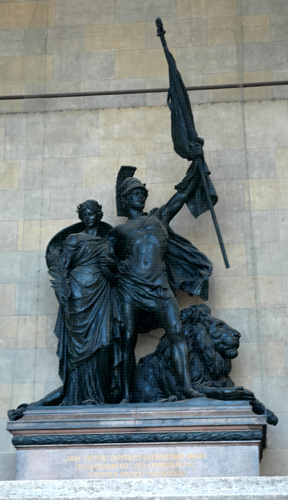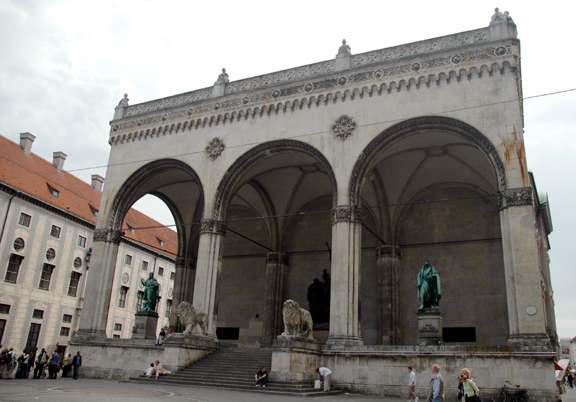Odeonsplatz in Munich, Germany

Feldherrenhalle - where
Hitler's 1923 Putsch ended
Odeonsplatz is a small square at the
end of Residenzstrasse near the Hofgarten, which is the people's
state garden. In the center of the square is the Feldherrenhalle,
shown in the photo above. The Odeon is a government building
which faces the square; it was originally a music college.
Until 1816, the site of the Feldherrenhalle
on Odeonsplatz was occupied by one of the Munich town gates,
the Schwabinger Tor. When Munich was expanded to include the
village of Schwabing in the early 19th century, architect Leo
von Klenze ordered the gate to be pulled down to make way for
Ludwigstrasse. The Feldherrenhalle was designed by Friedrich
von Gärtner; it was modeled on the Loggia dai Lanzi in Florence.
The Feldherrenhalle was built to honor the military heroes of
Bavaria.

Statue of German military
heroes

Feldherrenhalle is
between Residenzstrasse and Theatinerstrasse
The Feldherrenhalle has statues of Bavaria's
two greatest military heroes: Johann Tilley, the Imperial Field
Marshall in the Thirty Years War, and Karl Phillipp von Wrede,
the commander of the Bavarian troops which helped to defeat the
French at the Battle of the Nations. Bavaria originally fought
on the side of Napoleon, but later switched sides. Tilley was
the leader of the Catholic forces which fought the Protestants
in the Thirty Year's War; he figures prominently in the history
of Rothenburg ob der Tauber.

Statues of German military
heroes
On the evening of November 8, 1923, Adolf
Hitler announced the start of "the people's revolution"
in the Bürgerbräukeller, a Munich beer hall. Hitler
and his supporters then marched through the streets of Munich
in an attempt to seize power. This unsuccessful revolution became
known as Hitler's Beer-hall Putsch. The next day, on November
9th, Hitler and two thousand of his followers were stopped by
the Munich police on Residenzstrasse in front of the Feldherrenhalle;
four policemen and 16 of Hitler's supporters were killed in the
fighting. Hitler fled from the scene, but was later arrested
and imprisoned at Landsberg am Lech after a trial in which he
was convicted of treason.
The Bürgerbräukeller was torn
down years ago, but tourists can still see where the Nazis put
a plaque on the Feldherrenhalle to honor the men who were killed
there by the police. During the Nazi era, Munich residents were
required to do a Nazi salute as they passed the plaque, which
has since been removed. Those who did not want to give a salute
to the fallen heroes would use Viscardigasse, a back alley which
was nicknamed "Evaders' Alley."
November 9th is an important date in
German history because it is also the anniversary of the overthrow
of Kaiser Wilhelm by the Social Democrats in 1918 and the anniversary
of the tearing down of the Berlin wall in 1989. It is also the
anniversary of Kristallnacht in 1938 when Jewish shops and Synagogues
were burned by the Nazis.

St. Cajetan's Church
on Theatinerstrasse, Feldherrenhalle on the left
St. Cajetan's Church on the southwest
corner of Odeonsplatz was designed by Italian architect Agostino
Baralli; the design of the church was based on St. Andrea della
Valle in Rome. Construction work on the church itself ended in
1690, but the facade was built between 1765 and 1768. With its
twin towers and copper dome, St. Cajetan's, aka Theatinerkirche,
is one of the most magnificent churches in Munich. It is an example
of late Baroque style architecture. Inside the church are the
tombs of nearly all the members of the royal Wittelsbach family
which ruled Bavaria for 400 years until they were overthrown
on November 7, 1918 by Communists led by Kurt Eisner.
Back to Munich
Home
This page was created on July 29, 2007
|